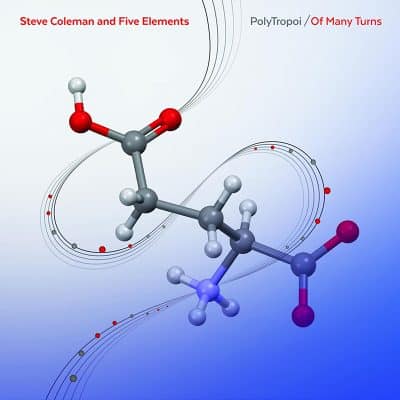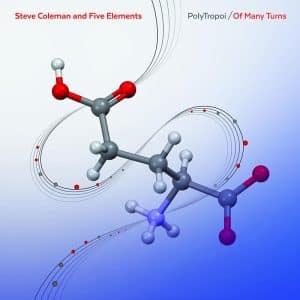Steve Coleman and Five Elements PolyTropos/Of Many Turns
 Steve Coleman and Five Elements
Steve Coleman and Five Elements
PolyTropos/Of Many Turns
Pi Recordings
The level of improvisational interconnectivity and telepathy in alto saxophonist Steve Coleman’s Five Elements band almost defies logic. Coleman and trumpeter Jonathan Finlayson flawlessly finish each other’s sentences throughout the course of pieces that often run for 17 and 18 minutes. Yet, as soon as one realizes this, the bass-rhythm tandem of Rich Brown and Sean Rickman not only provide sturdy grooves but enable the unit to write fluent paragraphs. Unlike so many improvising groups bent solely on experimentation, Coleman’s group also seems purposeful and forward moving whether Coleman and Finlayson are playing in unison, contrapuntally, or as harmonic foils for the other. PolyTropos/Of Many Turns, like all of the band’s recent output, is recorded live, comprised of two sets during a March, 2024 tour in France. Disc One is Live at New Morning, Paris and Disc 2 is Live at Salle des fetes de Voiron.
Let’s break this down in an effort to explain how they achieve this. The band, excepting new member Brown, have been playing together for twenty-five years. Obviously they know each other’s tendencies intimately. Secondly, they have an unusual setup for a jazz band, arranged in a semi-circle, like a bluegrass band gathered around one mic or a drum circle. This enables them to have eye contact and feed off hand gestures and such. Finally, the band name itself means interconnectivity as it’s about the five building blocks of the universe – air, fire, water, earth, and space. Coleman has translated this to five musical elements – melody, harmony, rhythm, timbre, and patterns. Coleman moves through sets of ideas rather than written pieces and works without a set list. The music is gloriously democratic, with every instrument contributing tonally and rhythmically. It’s free flowing, spontaneous, mixing pretermined and spontaneous figures. It takes many twists and turns along the way. The music rests mostly on staccato bursts of three-five notes, sometimes a bit longer as if each instrument is a pitched drum, tracing to the Africa diaspora. Listen closely and you’ll hear several strains of Black music from bebop and its variations to hip-hop to James Brown-like R&B, and the blues. The sound here is pristine and the band definitely feeds off the audience’s excitement. As you listen, you can envision them on the edge of their seats waiting for the next unexpected turn or surprise. When the piece finishes, they generally erupt in enthusiastic applause. My initial reaction was a kind of a shock and awe wow yet as you listen to both discs you’ll note a similarity in many of the patterns. Clearly these four are comfortable and confident throughout.
As you’ll hear on several pieces here, especially on Disc 2 Coleman will begin the piece with a soliloquy where his pure tone flows poetically. Unlike many of the ‘out’ players, his approach is free of shrieks and squalls. Check out the opener to Disc 2 – “Lush Life cadenza/Pi” or “Round Midnight,” also on Disc 2 as examples. These solos stand as opposites to his ensemble playing which jabs, swells, and swings in its own way with a complex system of call and response where the two horns can overlap, challenge the other, spar, or join in bright harmonies. Seriously, there is no band that serves as a reference point.
Without delving too much into Coleman’s background, it’s important to point out how cerebral he is. He draws much of his inspiration from concepts outside of music. The Yoruban divination system lies behind The Mancy of Sound, Functional Arrhythmias is about the human heartbeat, Synavial Joints is about human joints, and his two Village Vanguard recordings are about boxing and Egyptian hieroglyphs. As you may glean from the cover art of this one, Coleman bases it on the structural chains of amino acid molecules. He says this, “Amino acid synthesis can occur in a variety of ways, so in my musical re-imagining of the biochemical reactions, the melodic cells formed through many different pathways, or ‘of many turns’ based on these patterns. The music could be called polytonal , in that intervals continuously bond in specific ways to form tonal molecules, which take the place of traditional harmonies.” Okay, got it? Surprisingly though, this music when compared to the bulk of avant garde or ‘out’ music is much more accessible. We’re not going to write about specific pieces. Sometimes, it’s best to let the music speak for itself. And really, after Coleman’s description what more can be added?
You owe yourself a listen. Steve Coleman and Five Elements is unlike anything else you’ll hear.
– JIm Hynes
BUY NOW
Buy Us a Cup of Coffee!
Join the movement in supporting Making a Scene, the premier independent resource for both emerging musicians and the dedicated fans who champion them.
We showcase this vibrant community that celebrates the raw talent and creative spirit driving the music industry forward. From insightful articles and in-depth interviews to exclusive content and insider tips, Making a Scene empowers artists to thrive and fans to discover their next favorite sound.
Together, let’s amplify the voices of independent musicians and forge unforgettable connections through the power of music
Make a one-time donation
Make a monthly donation
Make a yearly donation
Buy us a cup of Coffee!
Or enter a custom amount
Your contribution is appreciated.
Your contribution is appreciated.
Your contribution is appreciated.
DonateDonate monthlyDonate yearlyYou can donate directly through Paypal!
Subscribe to Our Newsletter
Discover more from Making A Scene!
Subscribe to get the latest posts sent to your email.














































